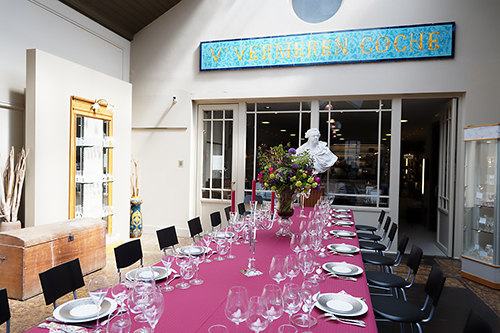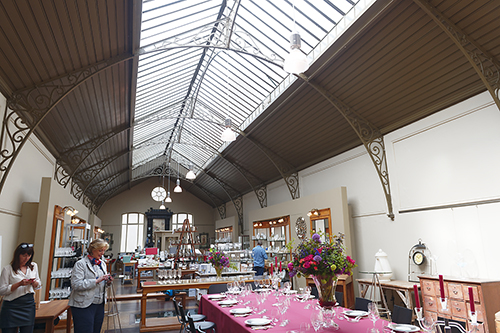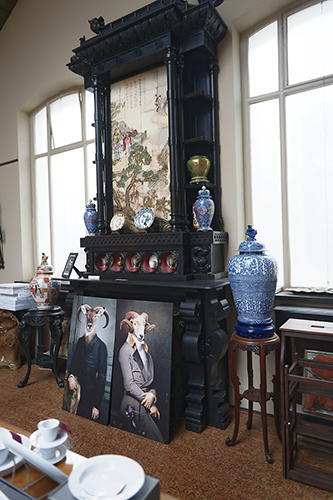 After a few years of hesitation caused by the economic recession due to the events of the late eighteenth and early nineteenth century, the art of porcelain reborn in the suburbs of lxelles in 1818. After a few years of hesitation caused by the economic recession due to the events of the late eighteenth and early nineteenth century, the art of porcelain reborn in the suburbs of lxelles in 1818.
Frédéric Théodore Faber, "painter of the king and merchant at the court" moved then "Faubourg de Namur" (that is what was then called the top of Ixelles), Chaussée d'Etterbeek n ° 41 ( today Chaussée de Wavre), at the current location of the Writers' House.
Frédéric Théodore Faber is a chambrelan.
He decorates porcelain in his room.
Encouraged and financially supported by King William I of the Netherlands, he founded a real porcelain factory which we call "Ixelles 1".
In 1824, to extend his crafts to the manufacture of porcelain itself, Frédéric Théodore Faber teamed with Charles-Christophe Windisch, a porcelain native of Niderviller in Lorraine.
The latter, raised in a porcelain family tradition, apprenticed to his father and worked for many factories in Paris and Limoges.
Faber's miniaturist painter talent and Windisch's technical expertise complement each other and make their company successful.
Together they produce some very beautiful creations that could support the comparison with pieces produced in Sèvres.
However, the political events which preceded and determined in 1830 the break of Belgium with Holland, will be a fatal blow to their association.
Faber, a Protestant, remains faithful to King William I, his benefactor.
He is in favor of the union of Holland and the southern provinces.
For his part, Windisch is of French origin and friend of Jean-Jacques Coché Mommens, publisher of the "Courrier des Pays Bas, opposition newspaper to the Dutch regime.
He is in favor of the independence of Belgium.
The two partners separate in 1830.
Windisch then finds in his friend Jean-Jacques Coché-Mommens a comrnanditeur.
It can be established on its own almost in front of its former factory, at no. 183 of the Chaussée d'Etterbeek (currently 141,143 chaussée de Wavre) in rather large premises of the relay called "Au mayeur Cabaret" (Inn where the carriages stopped to avoid being subject to the entrance fee of the city).

Thus is born the second porcelain factory of Ixelles or Ixelles II, we are late 1830.
The Faber manufacture continues after the death of this one in 1844 under the direction of his two sons, Henri Emmanuel and Louis, until 1849.
Then, it will be taken again by the Cappelmans, family of porcelainiers in Hal.
In 1869, the furnaces of Ixelles I go out permanently.
For its part, the Winsdisch factory, Ixelles II, will experience continuous development throughout its existence.
When Windisch died in 1842, Jean-Jacques Coché Mommens helped Windisch set up his
Manufacture, sought no doubt a replacement to the latter and perhaps even ensured the administrative management of the case before the arrival nine months later, of Michel Ernest Antoine Caillet, porcelainier in Paris and his wife Caroline Françoise Pouchelain, first widow of Nicolas Jean Eugène Coché, brother of Jean-Jacques Coché.
Michel Caillet does not bring about any profound upheavals in the production of the Manufacture, he continues to
manage it just like Windisch did.
The case remains prosperous and Caillet is content with it while maintaining a determined desire for a job well done.
Like Windisch, Caillet has left us a collection of forms that testifies to his talent.
After nine years of activity, husband and wife Caillet without heirs will give in 1852 their industrial exploitation to the married Vermeren Coché.
Monsieur Emile Theodore Vermeren, professor at the Royal Athenaeum at Ixelles, had married Chantal Coché, daughter of Jean-Jacques Coché Momrnens, and niece of the Caillet couple.
The factory will know under his direction of the enlargements, an increase of the personnel and a
renewal of manufacturing. Mr. Emile Vermeren has a very dynamic spirit. He introduces a complete conversion of the manufacture and the construction of a second large oven, unfortunately he died unexpectedly at the age of 47 in 1869 after 17 years of management.
Chantal Vermeren-Coché continues this work alone and continues the growth policy started by her husband.
The number of people employed by the factory increases considerably (60 people in 1871, 200 people in 1881).
The manufactory makes live a good part of the population of Ixelles.
From 1870, the business of Mrs. Veuve Vermeren-Coché became in addition to a factory, an important commercial complex distributing productions of large European factories.
In large exhibition halls, porcelain from Limoges, Wedgwood, Copeland, Copenhagen, Berlin and Meissen are next to the crystals of Val-Saint-Lambert, Baccarat, Saint-Louis, Daum ...
There is, as now again, a wide range of the art of the table and decoration.
The revival of the manufacture was considerable for more than half a century until 1905, carried out masterfully by Madame Vermeren-Coché.
The latter had been prepared for this task by her family background and, in particular, by her father, the publisher JJ Coché, whose strong personality formed in her a clear, persevering and enterprising spirit that can be described as exceptional for a woman of this time.
She was one of the first women to be decorated with the Legion of Honor.
Mrs. Chantal Vermeren-Coché did not have children but she raised Marthe Coché, the daughter of her brother Jean.
The latter married in 1895 Louis Robert Demeuldre, an officer, from a military family.
Captain Demeuldre then resigned to take with his wife, the replacement of the old aunt Chantal in 1900.
His training allowed him to quickly learn about manufacturing techniques.
In 1905, with Madame Vermeren-Coché, he decided on the construction of the facade that you can still see on the Wavre road in its original state.
It is made by architect Maurice Bischop of Horta school.
In addition to table service, Mr. Louis Demeuldre has developed other branches of porcelain manufacturing, including electrical engineering finding wide employment in the emerging electricity industry. (For example, the factory supplied the Spanish electricity company with all the porcelain insulators of its electrical poles).
At this time, the management wants to expand the factory, but this will not be feasible because the city has grown around the plant, trapping between houses and buildings.
A project then sees the day: move the factory to the outskirts of Brussels, towards Wezembeek-Oppem.
Land is bought, the plans of the new factory are definitively established but the war breaks out in 1914.
The project will be irrevocably abandoned because of the death of the youngest brother of Mr. Louis Demeuldre, who should be entrusted with the management of this new factory.
However Louis Demeuldre maintains the factory of the roadway of Wavre in activity.
He planned to leave it to his nephew, Henry Demeuldre, son of his youngest brother who died in the war.
At the death of her husband in 1933, Mrs. Marthe Demeuldre-Coché continued the operation of the factory helped by her nephew Henry, which she would then adopt.
The factory is in great need of modernization, and in 1935, they plan to move the factories to Andenne, land ceramic tradition and Jambes but these projects will also be abandoned.
After so many vain attempts to relocate outside Brussels, Henry Demeuldre Coché, who took over the technical direction of the factory, resolves to modernize the plant on site.
In 1937 he decided to make his own porcelain paste, and in 1938 he replaced the coal-fired kiln with town gas.
During the Second World War, the manufacturing division, deprived of the presence of Mr. Henry Demeuldre Coché, engaged as a war volunteer, suffered greatly.
Despite major modernization efforts, the factory is no longer profitable.
Stifled by its situation in the urban agglomeration, suffering from an ever greater shortage of specialized personnel, and competing with the renovation and rapid rebuilding of French and German manufactures after the war, the manufacturing division must stop all production in 1953, to avoid more to devote himself to the decoration of white, imported from Limoges mainly.
This activity will continue until the seventies.
Distribution continues to expand, offering an ever wider range of products.
Henry Demeuldre Coché, helped by his wife, Andrée Tombois is one of the precursors of the marriage list in Belgium. Activity whose fame is still alive today far beyond our borders, thanks to the mutual trust between the Establishments and a faithful clientele from generation to generation for more than 180 years.

On the death of Mr Henry Demeuldre Coché, in 1983 his wife will continue with her two daughters Chantal and Françoise to manage this heritage.
In 1997, Françoise Demeuldre Coché took over the management of Etablissements Demeuldre.
Since childhood, Françoise has always lived to the rhythm of Etablissements Demeuldre.
By vocation, since the 80s, she constantly energizes her house.
With a remarkable experience and knowledge in the field of tableware - few people could claim them - she places her shop among the places not to be missed to find anything that will embellish a table and a table. exceptional interior or simply serve the everyday. His sense of advice and service will be precious to everyone!
In 2005, it hosts in the old workshops of the manufacture, a restoration workshop of porcelain, earthenware, plaster, crystal, glass, glass paste, marble, stone, enamels, ivory, alabaster, biscuit, stoneware, ceramic, jade. ..
The Coperta Workshop and thus renew with the past.
A collaboration with a porcelain painter, Madame Marie-Laure Degand, also perpetuates the tradition of all the illustrious predecessors of the porcelain factory of Ixelles IL
Chantal Vermeren-Coché continues this work alone and continues the growth policy started by her husband. The number of people employed by the factory increases considerably (60 people in 1871, 200 people in 1881).
The manufactory makes live a good part of the population
of Ixelles.
From 1870, the business of Mrs. Veuve Vermeren-Coché became in addition to a factory, an important commercial complex distributing productions of large European factories. In large exhibition halls, porcelain from Limoges, Wedgwood, Copeland, Copenhagen, Berlin and Meissen are next to the crystals of Val-Saint-Lambert, Baccarat, Saint-Louis, Daum ... We find, as now again, a wide range of the art of the table and decoration.
The revival of the manufacture was considerable for more than half a century until 1905, carried out masterfully by Madame Vermeren-Coché. The latter had been prepared for this task by her family background and, in particular, by her father, the publisher JJ Coché, whose strong personality formed in her a clear, persevering and enterprising spirit that can be described as exceptional for a woman of that time. She was one of the first women to be decorated with the Legion of Honor.
Mrs. Chantal Vermeren-Coché did not have children but she raised Marthe Coché, the daughter of her brother Jean. The latter married in 1895 Louis Robert Demeuldre, an officer, from a military family.
Captain Demeuldre then resigned to take with his wife, the replacement of the old aunt Chantal in 1900.
His training allowed him to quickly learn about manufacturing techniques. In 1905, with Madame Vermeren-Coché, he decided on the construction of the facade that you can still see on the Wavre road in its original state. It is made by architect Maurice Bischop of Horta school.
In addition to table service, Mr. Louis Demeuldre has developed other branches of porcelain, especially electrical engineering found an extempted use in the emerging electricity industry. (For example, the factory supplied the Spanish electricity company with all the porcelain insulators of its electrical poles).
At this time, the management wants to expand the factory, but this will not be feasible because the city has grown around the plant, trapping between houses and buildings.
A project then sees the day: move the factory to the outskirts of Brussels, towards Wezembeek-Oppem. Land is bought, the plans of the new factory are definitively established but the war breaks out in 1914.
The project will be irrevocably abandoned because of the death of the youngest brother of Mr. Louis Demeuldre, who should be entrusted with the management of this new factory.
However Louis Demeuldre maintains the factory of the roadway of Wavre in activity.
He planned to leave it to his nephew, Henry Demeuldre, son of his youngest brother who died in the war.
At the death of her husband in 1933, Mrs. Marthe Demeuldre-Coché continued the operation of the factory helped by her nephew Henry, which she would then adopt.
The factory is in great need of modernization, and in 1935, they plan to move the factories to Andenne, land ceramic tradition and Jambes but these projects will also be abandoned.
After so many vain attempts to relocate outside Brussels, Henry Demeuldre Coché, who took over the technical direction of the factory, resolves to modernize the plant on site.
In 1937 he decided to make his own porcelain paste, and in 1938 he replaced the coal-fired kiln with town gas.

During the Second World War, the manufacturing division, deprived of the presence of Mr. Henry Demeuldre Coché, engaged as a war volunteer, suffered greatly.
Despite major modernization efforts, the factory is no longer profitable.
Stifled by its situation in the urban agglomeration, suffering from an ever greater shortage of specialized personnel, and competing with the renovation and rapid rebuilding of French and German manufactures after the war, the manufacturing division must stop all production in 1953, to avoid more to devote himself to the decoration of white, imported from Limoges mainly.
This activity will continue until the seventies.
Distribution continues to expand, offering an ever wider range of products.
Henry Demeuldre Coché, helped by his wife, Andrée Tombois is one of the precursors of the marriage list in Belgium.
Activity whose fame still continues today far beyond our borders,
thanks to mutual trust between the Establishments and a loyal generation clientele
in generation for more than 180 years.
On the death of Mr Henry Demeuldre Coché, in 1983 his wife will continue with her two daughters Chantal and Françoise to manage this heritage.
In 1997, Françoise Demeuldre Coché took over the management of Etablissements Demeuldre.
Since childhood, Françoise has always lived to the rhythm of Etablissements Demeuldre. By vocation, since the 80s, she constantly energizes her house. With a remarkable experience and knowledge in the field of tableware - few people could claim them - she places her shop among the places not to be missed to find anything that will embellish a table and a table. exceptional interior or simply serve the everyday.
His sense of advice and service will be precious to everyone!
In 2005, it hosts in the old workshops of the manufacture, a restoration workshop of porcelain, earthenware, plaster, crystal, glass, glass paste, marble, stone, enamels, ivory, alabaster, biscuit, stoneware, ceramic, jade. ..
The Coperta Workshop and thus renew with the past.
A collaboration with a porcelain painter, Madame Marie-Laure Degand, also perpetuates the tradition of all the illustrious predecessors of the porcelain factory of Ixelles IL
|
 After a few years of hesitation caused by the economic recession due to the events of the late eighteenth and early nineteenth century, the art of porcelain reborn in the suburbs of lxelles in 1818.
After a few years of hesitation caused by the economic recession due to the events of the late eighteenth and early nineteenth century, the art of porcelain reborn in the suburbs of lxelles in 1818.


